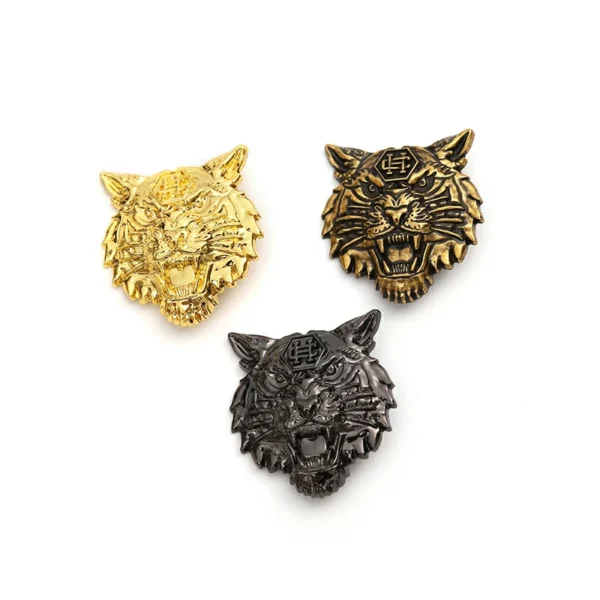Metal clothing labels are used for various purposes in the fashion industry.
Here are some common uses and benefits of metal clothing labels:
- Branding and Identification: Metal clothing labels are often used to display the brand name, logo, or emblem of a clothing company or designer. They serve as a visual representation of the brand and help establish brand recognition and identity. The presence of a metal label on clothing adds a premium and high-quality feel to the product.
- Product Differentiation: Metal labels can help differentiate a clothing item from others in the market. The unique design, shape, and finish of the metal label can set a brand apart and make the clothing item more visually appealing. It adds a distinctive touch and can attract customers who appreciate attention to detail and craftsmanship.
- Durability and Longevity: Metal clothing labels are known for their durability and longevity. They are resistant to wear, fading, and fraying, ensuring that the label remains intact and legible even after multiple washes or years of use. This makes them particularly suitable for high-quality garments that are designed to last.
- Enhanced Aesthetics: Metal labels can enhance the overall aesthetics of a clothing item. The metallic finish adds a touch of elegance, sophistication, and luxury to the garment. The labels can be customized with various finishes, such as polished, brushed, or antique, to achieve the desired look and feel.
- Sew-On or Heat Transfer Options: Metal clothing labels can be designed for sew-on application or heat transfer application, depending on the garment and brand preference. Sew-on labels require stitching onto the clothing item, while heat transfer labels adhere to the fabric using heat and pressure. Both options offer secure attachment and ensure the label remains in place.
- Versatility: Metal clothing labels can be used on a wide range of garments, including jeans, jackets, shirts, dresses, accessories, and more. They are versatile and can be customized in various sizes, shapes, and designs to suit different clothing styles and brand aesthetics.
- Brand Authenticity and Quality Assurance: The presence of a metal clothing label on a garment signifies attention to detail and quality. It acts as a mark of authenticity, indicating that the garment has been produced by a reputable brand or designer. This can instill confidence in customers and contribute to a positive brand image.
- Customization Options: Metal clothing labels offer a wide range of customization options. They can be personalized with embossed or debossed logos, raised or recessed lettering, textured backgrounds, unique shapes, and various metal finishes. Customization allows brands to create labels that align with their specific design preferences and brand identity.
Overall, metal clothing labels serve as a form of brand identification, custom metal clothing labels add aesthetic appeal, and contribute to the perceived quality and value of a garment. They are a popular choice for fashion brands looking to enhance their branding efforts and create a lasting impression on customers.
What should custom metal clothing labels pay attention to?
When customizing metal clothing labels, there are several important factors to consider to ensure a successful outcome. Here are some key aspects to pay attention to:
- Design and Branding: Create a visually appealing design that represents your brand identity and aligns with your overall branding strategy. Consider factors such as logo placement, font style, color scheme, and any additional design elements that reflect your brand’s aesthetics.
- Material Selection: Choose the appropriate metal material for your clothing labels. Common options include brass, zinc alloy, stainless steel, or aluminum. Consider factors such as durability, weight, and the desired aesthetic finish when selecting the material. Each metal has its own unique properties and can contribute to the overall look and feel of the label.
- Size and Shape: Determine the appropriate size and shape of the metal label for your garments. Consider the available space on the clothing item and ensure that the label is proportionate to the overall design. The shape of the label can be customized to match your brand’s style, whether it’s a traditional rectangular shape, a unique logo shape, or a custom die-cut design.
- Attachment Method: Consider the attachment method for your metal clothing labels. The two common options are sew-on labels and heat transfer labels. Sew-on labels require stitching onto the garment, while heat transfer labels adhere to the fabric using heat and pressure. Choose the method that best suits your garment type and design requirements.
- Customization Options: Explore the various customization options available for metal clothing labels. These may include options such as embossed or debossed logos, raised or recessed lettering, textured backgrounds, color fills, and different metal finishes (e.g., polished, brushed, antique). Select the customization features that best represent your brand and enhance the visual appeal of the labels.
- Quality and Durability: Ensure that the metal clothing labels are of high quality and durability. The labels should be able to withstand regular wear and tear, including washing and ironing, without losing their appearance or functionality. Work with a reputable manufacturer or supplier who can provide quality assurance and ensure that the labels meet your specifications.
- Compliance with Regulations: Be aware of any regulations or guidelines related to clothing labels, such as material composition or labeling requirements in certain regions. Ensure that your customized metal labels comply with the applicable regulations to avoid any legal or compliance issues.
- Supplier Selection: Choose a reliable and experienced supplier or manufacturer for your custom metal clothing labels. Research and evaluate potential suppliers based on their track record, customer reviews, sample work, and ability to meet your specific customization needs. Collaborate closely with the supplier to ensure effective communication and a smooth production process.
By paying attention to these factors, you can create custom metal clothing labels that effectively represent your brand, enhance the visual appeal of your garments, and contribute to a positive customer experience.
